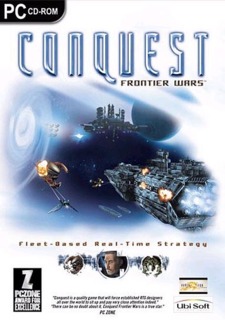An innovative classic with a few flaws
Conquest breaks the mold of standard real-time strategy from the start. Whereas many RTS games focus on armies and ground combat (perhaps with some air or water units thrown in for good measure) Conquest ditches all that and heads straight for space. Rather than move around infantry and cavalry on a single planet, you instead mobilize an interstellar battle fleet from orbital platforms constructed around dozens of planets.
Conquest's campaign and skirmish maps are assembled from a number of different solar systems containing planets, asteroid fields, and nebulae. In addition to providing resources, these terrain features can alter or restrict movement and even present hazards to wandering ships. Single or multiplayer skirmish games can last for hours on a large map, granting the game a truly epic interstellar scale as you coordinate offensives across multiple star systems.
Adding to the feeling of strategic realism and scope is the inclusion of the supply line mechanic. While ships can travel freely between systems via interconnecting wormholes, structures will not function in a system without an established supply line. Unless a star system has been connected to one of your headquarters with a jump gate, ships cannot be built, resources cannot be gathered, and research cannot be carried out.
This focus on logistics applies to your ships as well; warships have a finite amount of onboard supplies that limits their ability to fire. Without supplies, your ships will quickly run dry and be left defenseless against a better-supplied enemy. Fleets must eventually return to a supply or repair platform for resupply; for offensive missions into enemy territory, a commander must be sure to include vital supply ships in order to maintain their momentum.
Each of Conquest's three factions naturally have their own tech tree, structures, and units, and are varied and diverse enough to make playing each one a different experience. Although the claim of 'faction balance' is something of a cliche in this day and age, it does still hold true in Conquest's case. While the main campaign focuses largely on the Terran faction, it does provide opportunities to utilize the other factions' units, and all three sides can be played in skirmish mode.
The campaign itself is lengthy and challenging. The game unfortunately uses the same unit cap for both ships and fixed defenses, and the extremely small fixed unit cap for the campaign forces you to complete the mission objectives with the barest minimum fleet size possible. Given that the enemy forces on each map often seem much larger and stronger than your own, it can sometimes take multiple attempts to complete each mission. This does have the benefit, however, of sharpening your skills and forcing you to become an expert fleet handler.
Like most modern RTS games, you must build a mix of light and heavy units in order to effectively combat the enemy. Large dreadnaughts can absorb and inflict tremendous damage, but are slow and vulnerable to fighters and area of effect attacks, making it necessary to escort them with fighter-killing frigates and long-range carriers. Wormholes present natural 'choke-points' for establishing defensive front lines, and each side has a number of armed space stations that can be built to help slow down invasions.
Conquest does have a few design issues that make command and control difficult. There is literally no quantitative data available on your ships; apart from bland graphical indicators that note your researched tech levels, there is no way of knowing exactly how fast a given ship goes, how strong its armor is, or how much damage it does per volley. Conquest was designed prior to the development of the now fairly-common RTS 'tab-select' feature for shuffling through to a specific unit in a group. This makes it difficult to save a badly-damaged ship by moving it out of battle, as there is no way to quickly order it to run for a repair yard.
Conquest is able to alleviate this somewhat through the use of the Admiral system. In the campaign, Admirals fly in super-powerful versions of the stock ships, and largely fill the role of hero units. These hero ships are unavailable in skirmish mode, (unfortunately); skirmish Admirals instead fly simple shuttles that must be attached to a larger unit, allowing you to assemble a larger fleet around their flagship. This enables you to command the entire group, send the fleet in for repair and resupply, and gives you immediate access to each ship type's special abilities. Since each skirmish Admiral provides a number of passive bonuses against specific enemy factions and to certain types of ships, you can tailor your fleets to most effectively combat your opponents.
If you're a die-hard RTS junkie or a nostalgic fan of older real-time strategy games, then Conquest is definitely an excellent choice. In spite of its lack of 3D graphics, flashy particle effects, and some modern RTS control systems, Conquest: Frontier Wars is a solid game, particularly in Skirmish mode. A large map can feel more like a hybrid RTS/4x (the grandpa of Sins of A Solar Empire, maybe?) than an older, straight-up real-time strategy game. (Personally, I think that Conquest is a great candidate for an update - either by modern mod or remake.) No matter what your interest, if you can find a copy kicking around, I definitely recommend picking it up.

